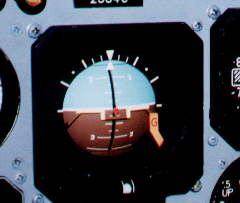 |
|||||
| Home | Research | For Teachers | HISTORY Level 1 Level 2 Level 3 |
PRINCIPLES Level 1 Level 2 Level 3 |
CAREER Level 1 Level 2 Level 3 |
| Gallery | Hot Links | What's New! | |||
| Web Administration and Tools | |||||
 |
|||||
| Home | Research | For Teachers | HISTORY Level 1 Level 2 Level 3 |
PRINCIPLES Level 1 Level 2 Level 3 |
CAREER Level 1 Level 2 Level 3 |
| Gallery | Hot Links | What's New! | |||
| Web Administration and Tools | |||||
![]()

Provides a substitute for the earth's horizon. The attitude indicator displays scales that
allow the pilot to set climb/dive angles and bank angle (VERY important aspects of
instrument flying).
The attitude indicator plays a vital role in overcoming our sensory information that
serves us well on the ground but provides incorrect and disorienting data at night or in
the weather. The following list addresses some of the false sensations a pilot can
experience from the inner ear (vestibular system):
ACTION: Prolonged constant turn
SENSATION: No sensation of turning
ACTION: Forward acceleration
SENSATION: Tilting backwards (sensation of climbing)
ACTION: Accelerating in a turn
SENSATION: Sensation of turning clockwise
Another sensory source that can provide incorrect data is the somatosensory system
(commonly referred to as "seat of the pants"). On the ground, our numerous
"sensors" of the somatosensory system feel the pull of gravity and tell us which
way is down. However, in flight a pilot can pull "Gs" that are greater than the
force of gravity (a 60 degree level turn produces 2 "Gs" or twice the force of
gravity) and override this system making the pilot think that "down" is
somewhere it isn't!
Send all comments to ![]() aeromaster@eng.fiu.edu
aeromaster@eng.fiu.edu
© 1995-98 ALLSTAR Network. All rights reserved worldwide.
| Funded in part by | Used with permission From 90th Fighter Squadron "Dicemen" Aviation |
Updated: February 24, 1999